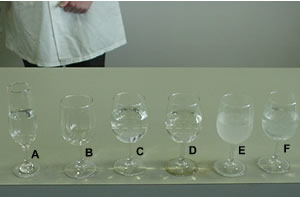A) Equal
amounts of Sodium carbonate (0.5M) and potassium iodide (0.1M)
B) Phenolphthalein indicator.
C) Hydrochloric acid (2M)
D) Hydrogen peroxide (10%V)
E) Starch solution (10g/l)
F) Sodium thiosulfate (0.1M)
Solutions of the following should also be made available in eye dropper bottles.
Phenolpthalein solution
Sodium carbonate (0.5M)
Potassium iodide (0.1M)
Hydrogen peroxide (2M)
Starch solution
Sodium thiosulfate (0.1M)

Add a small amount of each solution into a separate wine glass. Pour each solution into the other sequentially.
Can you explain the chemistry behind each reaction.
1) What is produced when a carbonate reacts with an acid?
2) When a carbonate reacts with an acid carbon dioxide gas is one of the products. What two reactants are present in solution A and C that will produce a gas when mixed together?
3) Phenolphthalein is a chemical that changes colour when a solution is basic. A solution is basic when there is more OH- ions in the water than H+ ions. A neutral solution has an equal number of each as is the case with pure water.
When solutions A and B are mixed the resulting solution turns red indicating the presence of a base. Identify this base through investigation.
4) Why does the red colour disappear when placed into solution C? Use your knowledge of pH and indicators from previous classes.
5) Hydrogen peroxide reacts to take electrons from the I- ions and form I2 molecules, which appear brown in solution. The I- ions are present from the 0.1M potassium iodide solution that was added to form solution A. The reaction takes place according to the equation below.
2H2O2(aq) + 2I-(aq) => 2H2O(l) + I2)(aq + O2(g)
When solution C is added to D a brown colour is produced and gas is formed.
i)
Identify the gas.
ii) What forms the brown colour?
6)
What reactants form the brown colour of Coke when solutions D and E are mixed?
7)
Sodium thiosulfate acts opposite to hydrogen peroxide in that it gives electrons back to the brown I2 molecules to change them back to the colourless I- ions .
i) What evidence is there of a chemical reaction when solutions E and F are mixed?
ii)
The general name for a chemical that takes electrons from another is
iii) The general name for a chemical that gives electrons to another is
Another
great chemical demonstration is the "Magic Bottle" .
Obtain a 1L volumetric flask. Dissolve 5 grams of KOH, 3 grams of glucose
and a pinch of methylene blue in 250 mls of water. Stopper the flask and
shake. The liquid is initially colourless but quickly turns blue on shaking.
The process can be repeated several times.
Research.
1) Why does the solution need to be shaken before it turns blue?
2) What is the purpose of the methylene blue?
3) What happens when the bottle is left to settle and the blue colour disappears?